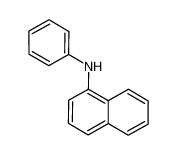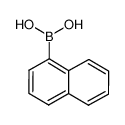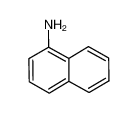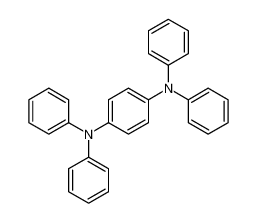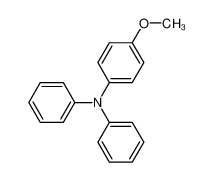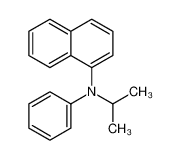| Product name | N-Phenyl-1-naphthylamine |
|---|
| Product number | - |
|---|---|
| Other names | 1-Naphthalenamine, N-phenyl- |
| Identified uses | For industry use only. Intermediates,Lubricants and lubricant additives |
|---|---|
| Uses advised against | no data available |
| Company | MOLBASE (Shanghai) Biotechnology Co., Ltd. |
|---|---|
| Address | Floor 4 & 5, Building 12, No. 1001 North Qinzhou Road, Xuhui District, Shanghai, China |
| Telephone | +86(21)64956998 |
| Fax | +86(21)54365166 |
| Emergency phone number | +86-400-6021-666 |
|---|---|
| Service hours | Monday to Friday, 9am-5pm (Standard time zone: UTC/GMT +8 hours). |
Acute toxicity - Oral, Category 4
Skin sensitization, Category 1
Specific target organ toxicity – repeated exposure, Category 2
Hazardous to the aquatic environment, long-term (Chronic) - Category Chronic 1
2.2 GHS label elements, including precautionary statements| Pictogram(s) |    |
|---|---|
| Signal word | Danger |
| Hazard statement(s) | H302 Harmful if swallowed H317 May cause an allergic skin reaction H373 May cause damage to organs through prolonged or repeated exposure H410 Very toxic to aquatic life with long lasting effects |
| Precautionary statement(s) | |
| Prevention | P264 Wash ... thoroughly after handling. P270 Do not eat, drink or smoke when using this product. P261 Avoid breathing dust/fume/gas/mist/vapours/spray. P272 Contaminated work clothing should not be allowed out of the workplace. P280 Wear protective gloves/protective clothing/eye protection/face protection. P260 Do not breathe dust/fume/gas/mist/vapours/spray. P273 Avoid release to the environment. |
| Response | P301+P312 IF SWALLOWED: Call a POISON CENTER/doctor/…if you feel unwell. P330 Rinse mouth. P302+P352 IF ON SKIN: Wash with plenty of water/... P333+P313 If skin irritation or rash occurs: Get medical advice/attention. P321 Specific treatment (see ... on this label). P362+P364 Take off contaminated clothing and wash it before reuse. P314 Get medical advice/attention if you feel unwell. P391 Collect spillage. |
| Storage | none |
| Disposal | P501 Dispose of contents/container to ... |
none
3.Composition/information on ingredients 3.1 Substances| Chemical name | Common names and synonyms | CAS number | EC number | Concentration |
|---|---|---|---|---|
| N-Phenyl-1-naphthylamine | N-Phenyl-1-naphthylamine | 90-30-2 | none | 100% |
Consult a physician. Show this safety data sheet to the doctor in attendance.
If inhaledFresh air, rest. Refer for medical attention.
In case of skin contactRemove contaminated clothes. Rinse skin with plenty of water or shower.
In case of eye contactFirst rinse with plenty of water for several minutes (remove contact lenses if easily possible), then refer for medical attention.
If swallowedRinse mouth. Refer for medical attention .
4.2 Most important symptoms/effects, acute and delayedACUTE/CHRONIC HAZARDS: When heated to decomposition this compound emits toxic fumes.
4.3 Indication of immediate medical attention and special treatment needed, if necessary Absorption, Distribution and ExcretionIn male Sprague-Dawley rats administered a single oral dose of 160 mg [14C] N-phenyl-1-naphthylamine/kg bw, the chemical was well absorbed, metabolized almost completely, and excreted primarily in the feces. Radioactivity was detected in plasma within 60 min, with the maximum concentration measured after 4 hr. After 24 hr, 20% of the radioactivity was found in the GI tract (including contents), 2.4% in fatty tissue, 0.4% in the liver, and 0.1% in the kidneys. 90% of the administered radioactivity was excreted within 48 hr; 95% was excreted within 72 hr (60% in the feces and 35% in the urine).
5.Fire-fighting measures 5.1 Extinguishing media Suitable extinguishing mediaPowder, water spray, foam, carbon dioxide. ...In case of fire: keep drums, etc., cool by spraying with water. /from table/
5.2 Specific hazards arising from the chemicalFlash point data for this compound are not available. It is probably combustible.
5.3 Special protective actions for fire-fightersWear self-contained breathing apparatus for firefighting if necessary.
6.Accidental release measures 6.1 Personal precautions, protective equipment and emergency proceduresUse personal protective equipment. Avoid dust formation. Avoid breathing vapours, mist or gas. Ensure adequate ventilation. Evacuate personnel to safe areas. Avoid breathing dust. For personal protection see section 8.
6.2 Environmental precautionsSweep spilled substance into covered sealable containers. Carefully collect remainder. Then store and dispose of according to local regulations. Do NOT let this chemical enter the environment. Personal protection: P2 filter respirator for harmful particles.
6.3 Methods and materials for containment and cleaning upSweep spilled substance into sealable containers. Carefully collect remainder, then remove to safe place. Do NOT let this chemical enter the environment.
7.Handling and storage 7.1 Precautions for safe handlingAvoid contact with skin and eyes. Avoid formation of dust and aerosols. Avoid exposure - obtain special instructions before use.Provide appropriate exhaust ventilation at places where dust is formed. For precautions see section 2.2.
7.2 Conditions for safe storage, including any incompatibilitiesWell closed. Store in an area without drain or sewer access. Provision to contain effluent from fire extinguishing./Keep/ well closed.
8.Exposure controls/personal protection 8.1 Control parameters Occupational Exposure limit valuesno data available
Biological limit valuesno data available
8.2 Appropriate engineering controlsHandle in accordance with good industrial hygiene and safety practice. Wash hands before breaks and at the end of workday.
8.3 Individual protection measures, such as personal protective equipment (PPE) Eye/face protectionSafety glasses with side-shields conforming to EN166. Use equipment for eye protection tested and approved under appropriate government standards such as NIOSH (US) or EN 166(EU).
Skin protectionWear impervious clothing. The type of protective equipment must be selected according to the concentration and amount of the dangerous substance at the specific workplace. Handle with gloves. Gloves must be inspected prior to use. Use proper glove removal technique(without touching glove's outer surface) to avoid skin contact with this product. Dispose of contaminated gloves after use in accordance with applicable laws and good laboratory practices. Wash and dry hands. The selected protective gloves have to satisfy the specifications of EU Directive 89/686/EEC and the standard EN 374 derived from it.
Respiratory protectionWear dust mask when handling large quantities.
Thermal hazardsno data available
9.Physical and chemical properties| Physical state | off-white to slight brown crystalline powder |
|---|---|
| Colour | Prisms or needles from alcohol; leaflets from ligroin. |
| Odour | Amine-like |
| Melting point/ freezing point | 300°C(dec.)(lit.) |
| Boiling point or initial boiling point and boiling range | 200°C/10mmHg(lit.) |
| Flammability | Combustible. Gives off irritating or toxic fumes (or gases) in a fire. |
| Lower and upper explosion limit / flammability limit | no data available |
| Flash point | 80°C(lit.) |
| Auto-ignition temperature | no data available |
| Decomposition temperature | no data available |
| pH | no data available |
| Kinematic viscosity | no data available |
| Solubility | In water:insoluble |
| Partition coefficient n-octanol/water (log value) | log Kow = 4.20 |
| Vapour pressure | 1.13X10-5 mm Hg @ 25°C /Extrapolated/ |
| Density and/or relative density | 1.1 |
| Relative vapour density | no data available |
| Particle characteristics | no data available |
no data available
10.2 Chemical stabilityStable under recommended storage conditions.
10.3 Possibility of hazardous reactionsN-PHENYL-1-NAPHTHYLAMINE neutralizes acids in exothermic reactions to form salts plus water. May be incompatible with isocyanates, halogenated organics, peroxides, phenols (acidic), epoxides, anhydrides, and acid halides. Flammable gaseous hydrogen may be generated in combination with strong reducing agents, such as hydrides.
10.4 Conditions to avoidno data available
10.5 Incompatible materialsno data available
10.6 Hazardous decomposition productsWhen heated to decomposition it emits toxic fumes of /nitrogen oxides/.
11.Toxicological information Acute toxicity- Oral: LD50 Rat oral 1625 mg/kg
- Inhalation: no data available
- Dermal: no data available
no data available
Serious eye damage/irritationno data available
Respiratory or skin sensitizationno data available
Germ cell mutagenicityno data available
Carcinogenicityno data available
Reproductive toxicityno data available
STOT-single exposureno data available
STOT-repeated exposureno data available
Aspiration hazardno data available
12.Ecological information 12.1 Toxicity- Toxicity to fish: no data available
- Toxicity to daphnia and other aquatic invertebrates: LC50 Daphnia magna 0.06 mg/L/21 day; semi-static
- Toxicity to algae: no data available
- Toxicity to microorganisms: no data available
AEROBIC: N-Phenyl-1-naphthylamine, present at 100 mg/L, reached 0% of its theoretical BOD in 2 weeks using an activated sludge inoculum at 30 mg/L and the Japanese MITI test(1). In contrast, another test showed a 50% theoretical BOD in 5 days using a freshwater inoculum(2). Using an activated sewage inoculum, N-phenyl-1-naphthylamine (concentration of 2 ug/g) reached 70% of its theoretical BOD in 2 days(2). In screening tests, N-phenyl-1-naphthylamine present in a concentration of 2 ug/mL, reached 50% of its theoretical BOD in 10 days in Oneida Lake, NY water(2). Using acclimated lake water supplemented with nutrient broth, N-phenyl-1-naphthylamine (concentration of 2 ppm) reached 90% of its theoretical BOD after 10 days. N-Phenyl-1-naphthylamine was observed to degrade in a soil study, based on carbon dioxide evolution at rates of 7 and 17% 14CO2 evolution (40 nCi of 14CO2%-test compound/g soil) after 2 and 11 days, respectively(2).
12.3 Bioaccumulative potentialBCF ranges of 427-2,730 and 889 to 2,490 at 0.1 and 0.01 mg/L, respectively, were measured for N-phenyl-1-naphthylamine(SRC), using orange-red killifish (Oryzias latipes) which were exposed over an 8-week period(1). BCFs ranging from 432 to 1,285 (relative to radioactivity) and 233 to 694 (relative to test compound) were determined in a flow-through system for bluegill sunfish (Lepomis macrochirus) at steady state(2). According to a classification scheme(3), these BCF values suggest bioconcentration in aquatic organisms is high to very high(SRC), provided the compound is not altered physically or chemically once released into the environment.
12.4 Mobility in soilThe Koc of N-phenyl-1-naphthylamine is estimated as 4,600(SRC), using a measured log Kow of 4.2(1), and a regression-derived equation(2). According to a classification scheme(3), this estimated Koc value suggests that N-phenyl-1-naphthylamine is expected to have slight mobility in soil. The pKa of N-phenyl-1-naphthylamine is 4.93 at 25°C(4) indicating that this compound will partially exist in the cation form in the environment(3) Since N-phenyl-1-napthylamine exists in the protonated form, it will adsorb more strongly to organic carbon and clay than its neutral counterparts(5).
12.5 Other adverse effectsno data available
13.Disposal considerations 13.1 Disposal methods ProductThe material can be disposed of by removal to a licensed chemical destruction plant or by controlled incineration with flue gas scrubbing. Do not contaminate water, foodstuffs, feed or seed by storage or disposal. Do not discharge to sewer systems.
Contaminated packagingContainers can be triply rinsed (or equivalent) and offered for recycling or reconditioning. Alternatively, the packaging can be punctured to make it unusable for other purposes and then be disposed of in a sanitary landfill. Controlled incineration with flue gas scrubbing is possible for combustible packaging materials.
14.Transport information 14.1 UN Number| ADR/RID: UN3077 | IMDG: UN3077 | IATA: UN3077 |
| ADR/RID: ENVIRONMENTALLY HAZARDOUS SUBSTANCE, SOLID, N.O.S. |
| IMDG: ENVIRONMENTALLY HAZARDOUS SUBSTANCE, SOLID, N.O.S. |
| IATA: ENVIRONMENTALLY HAZARDOUS SUBSTANCE, SOLID, N.O.S. |
| ADR/RID: 9 | IMDG: 9 | IATA: 9 |
| ADR/RID: III | IMDG: III | IATA: III |
| ADR/RID: yes | IMDG: yes | IATA: yes |
no data available
14.7 Transport in bulk according to Annex II of MARPOL 73/78 and the IBC Codeno data available
15.Regulatory information 15.1 Safety, health and environmental regulations specific for the product in question| Chemical name | Common names and synonyms | CAS number | EC number |
|---|---|---|---|
| N-Phenyl-1-naphthylamine | N-Phenyl-1-naphthylamine | 90-30-2 | none |
| European Inventory of Existing Commercial Chemical Substances (EINECS) | Listed. | ||
| EC Inventory | Listed. | ||
| United States Toxic Substances Control Act (TSCA) Inventory | Listed. | ||
| China Catalog of Hazardous chemicals 2015 | Not Listed. | ||
| New Zealand Inventory of Chemicals (NZIoC) | Listed. | ||
| Philippines Inventory of Chemicals and Chemical Substances (PICCS) | Listed. | ||
| Vietnam National Chemical Inventory | Listed. | ||
| Chinese Chemical Inventory of Existing Chemical Substances (China IECSC) | Listed. | ||
| Creation Date | Aug 12, 2017 |
|---|---|
| Revision Date | Aug 12, 2017 |
- CAS: Chemical Abstracts Service
- ADR: European Agreement concerning the International Carriage of Dangerous Goods by Road
- RID: Regulation concerning the International Carriage of Dangerous Goods by Rail
- IMDG: International Maritime Dangerous Goods
- IATA: International Air Transportation Association
- TWA: Time Weighted Average
- STEL: Short term exposure limit
- LC50: Lethal Concentration 50%
- LD50: Lethal Dose 50%
- EC50: Effective Concentration 50%
- IPCS - The International Chemical Safety Cards (ICSC), website: http://www.ilo.org/dyn/icsc/showcard.home
- HSDB - Hazardous Substances Data Bank, website: https://toxnet.nlm.nih.gov/newtoxnet/hsdb.htm
- IARC - International Agency for Research on Cancer, website: http://www.iarc.fr/
- eChemPortal - The Global Portal to Information on Chemical Substances by OECD, website: http://www.echemportal.org/echemportal/index?pageID=0&request_locale=en
- CAMEO Chemicals, website: http://cameochemicals.noaa.gov/search/simple
- ChemIDplus, website: http://chem.sis.nlm.nih.gov/chemidplus/chemidlite.jsp
- ERG - Emergency Response Guidebook by U.S. Department of Transportation, website: http://www.phmsa.dot.gov/hazmat/library/erg
- Germany GESTIS-database on hazard substance, website: http://www.dguv.de/ifa/gestis/gestis-stoffdatenbank/index-2.jsp
- ECHA - European Chemicals Agency, website: https://echa.europa.eu/





